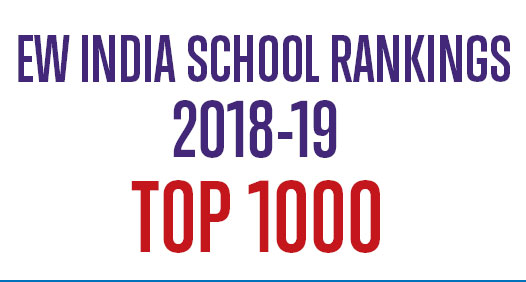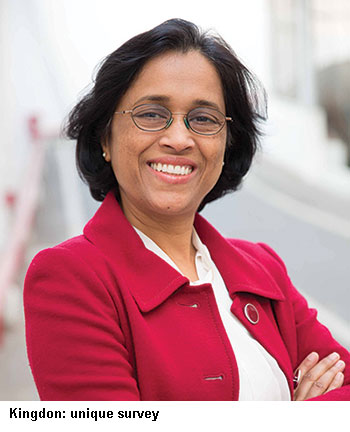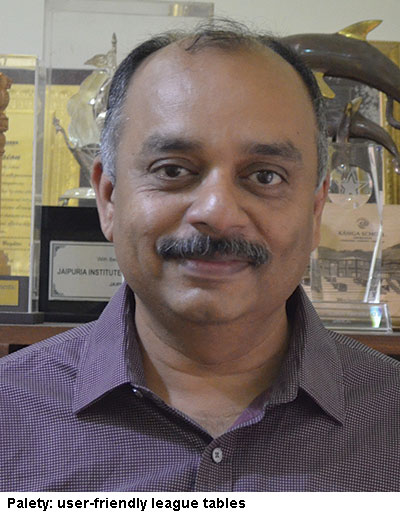To conduct the EWISR 2018-19 survey, field personnel of the Delhi-based C fore interviewed 12,214 SEC ‘A’ fees-paying parents, school principals, teachers and senior school students in 27 major cities and education hubs across India – Dilip Thakore & Summiya Yasmeen

During his 82-minute Independence Day speech delivered from the ramparts of Delhi’s Red Fort last month, prime minister Narendra Modi announced the imminent rollout of a path-breaking Ayushman Bharat health protection scheme which will provide health insurance coverage of Rs.500,000 per year to 100 million below-poverty-line households countrywide, and promised a new era of growth and prosperity for India in the years to come. However, the word ‘education’ wasn’t mentioned even once in his long and impassioned speech. Curiously, prime minister Modi or his speech writers don’t seem to be aware that root-and-branch reform of India’s moribund K-12 and higher education systems is the prerequisite of all socio-economic reform initiatives, including Swacch Bharat, Make in India, Double Farmers’ Incomes etc that the BJP/NDA government has initiated during the past four years.
Yet prime minister Modi’s indifference to education is not exceptional. For the past seven decades since independence, education — especially K-12 public education for the world’s largest child population — has been on the back-burner of successive governments at the Centre and in the states. Despite several high-powered national commissions starting with the Kothari Commission (1966) to the T.S.R. Subramanian Committee (2016) recommending that the annual expenditure (Centre plus states) on public education should be pegged at a minimum 6 percent of GDP, it has averaged a mere 3.5 percent and has never exceeded 4 percent. This explains why contemporary India indifferently hosts the world’s largest number of adult illiterates — over 300 million — and an equivalent number of under-educated youth who lack the minimal education and skills to earn enough to make a half-decent living.
 But even though the neta-babu brotherhood, which runs the Central and state governments, and all political parties with their batteries of economic advisers are yet to discover that high quality public and private education is the critical prerequisite of national development, this knowledge has impacted the public with huge force following the Millennium Declaration of the United Nations signed by 192 countries including India to ensure “every child in primary school and learning” by 2015. And perhaps also because EducationWorld — The Human Development Magazine was launched in 1999 with the stated mission “to build the pressure of public opinion to make education the #1 item on the national agenda”. Since then, there’s been tremendous churn in Indian education from early childhood to Ph D.
But even though the neta-babu brotherhood, which runs the Central and state governments, and all political parties with their batteries of economic advisers are yet to discover that high quality public and private education is the critical prerequisite of national development, this knowledge has impacted the public with huge force following the Millennium Declaration of the United Nations signed by 192 countries including India to ensure “every child in primary school and learning” by 2015. And perhaps also because EducationWorld — The Human Development Magazine was launched in 1999 with the stated mission “to build the pressure of public opinion to make education the #1 item on the national agenda”. Since then, there’s been tremendous churn in Indian education from early childhood to Ph D.
The market response to failing government schools are the country’s unique private budget schools (PBS) promoted by go-getting edupreneurs (education entrepreneurs) driven by a combination of enlightened self-interest and social activism. These schools which provide — or claim to provide — much-prized English-medium education offer low-income families an alternative to dysfunctional government schools which also tend to be averse to teaching English, notwithstanding the stark reality that it is the link language of India and the national and global language of business and industry.
Trendy leftists who dominate academia and the media like to pretend PBS don’t exist and/or would like to forcibly shut them down under the blatantly discriminatory s.19 of the Right of Children to Free & Compulsory Education (RTE) Act, 2009. This section prescribes several compulsory infrastructure and teacher-pupil ratio norms, failure to comply with which could invite heavy penalties and forcible closure of private (but not government) schools.
Nevertheless, PBS which have united under the Delhi-based National Independent Schools Alliance (NISA) have emerged as a formidable force to be reckoned with in primary/elementary education. According to Dr. Parth Shah, president of the Centre for Civil Society, a highly-respected Delhi-based think tank, PBS number over 400,000 countrywide and boast a staggering aggregate enrolment of 60 million children from low-income aspirational households. But since their clientele is poor, they are obliged to levy rock-bottom tuition fees which constrains them from hiring well-qualified teachers and installing enabling new technologies in their classrooms. Consequently, learning outcomes of PBS children are not significantly better than of their counterparts in government schools.
Against this dismal backdrop of government and establishment tokenism towards public education and hostility towards private schools, to acknowledge and felicitate primary-secondaries which are delivering high-quality, globally inspired education, in 2007, EducationWorld (estb.1999) introduced its first professionally curated annual league tables rating and ranking the country’s most admired schools on 12 parameters of excellence. Subsequently, the number of parameters (academic reputation, teacher competence, sports, co-curricular education, leadership, life skills, internationalism, special needs education etc) of education excellence were increased to 14, to rank schools according to the quality of holistic, multi-dimensional education they provide their students.
“Although several media publications and the government’s education department in the UK, some European countries and the US publish data about the academic performance of schools, the annual EducationWorld India School Rankings are unique because they evaluate and assess the country’s 1,000 better-known primary-secondary schools across 14 parameters of education excellence, including academic performance, on the basis of public perception of over 10,000 knowledgeable sample respondents. The exhaustive EWISR league tables serve a valuable public purpose inasmuch as they enable parents to choose schools which best match the aptitudes of their children along the different parameters. Moreover EWISR annually stimulates school managements to pay attention to continuous all-round improvement and promotes healthy inter-school competition which is in the public interest,” says Prof. Geeta Gandhi Kingdon, chair of education economics and international development at the Institute of Education, University College London and director of the City Montessori School, Lucknow, certified by the Guinness World Records as the world’s largest city school (57,000 students) and routinely ranked the #1 co-ed day school in Uttar Pradesh (pop. 215 million).
 To conduct the 2018-19 EWISR survey, the reputed Delhi-based market research and opinion polls company Centre for Forecasting and Research Pvt. Ltd (C fore, estb. 2000) constituted a sample respondents database of 12,214 SEC (socio-economic category) ‘A’ individuals including school principals, teachers, educationists, fees-paying parents and senior school students in 27 major cities and education hubs across India. Moreover, to rate and rank the best government and private budget schools parents in SEC ‘B’, ‘C’ and ‘D’ were also interviewed. The sample respondents were interviewed by 122 field personnel and persuaded to rate India’s most well-known 1,000 schools (pre-selected by EducationWorld) on the 14 parameters of education excellence cited above. The scores awarded under each parameter by respondents were totalled to rate and rank schools in each category inter se. “To make the ratings methodology more user friendly, the 10 point score awarded by respondents to schools under each parameter was multiplied by 10 and rounded off to the nearest number. All parameters were given equal weightage except the vitally important parameter of ‘competence of faculty’ which is given double weightage,” says Premchand Palety, promoter-CEO of C fore (estb. 2000).
To conduct the 2018-19 EWISR survey, the reputed Delhi-based market research and opinion polls company Centre for Forecasting and Research Pvt. Ltd (C fore, estb. 2000) constituted a sample respondents database of 12,214 SEC (socio-economic category) ‘A’ individuals including school principals, teachers, educationists, fees-paying parents and senior school students in 27 major cities and education hubs across India. Moreover, to rate and rank the best government and private budget schools parents in SEC ‘B’, ‘C’ and ‘D’ were also interviewed. The sample respondents were interviewed by 122 field personnel and persuaded to rate India’s most well-known 1,000 schools (pre-selected by EducationWorld) on the 14 parameters of education excellence cited above. The scores awarded under each parameter by respondents were totalled to rate and rank schools in each category inter se. “To make the ratings methodology more user friendly, the 10 point score awarded by respondents to schools under each parameter was multiplied by 10 and rounded off to the nearest number. All parameters were given equal weightage except the vitally important parameter of ‘competence of faculty’ which is given double weightage,” says Premchand Palety, promoter-CEO of C fore (estb. 2000).
Responding to criticism that perceptions of sample respondents under the parameter of ‘academic reputation’ are often unsatisfactory, since 2013 we have also been including class XII (and class X for K-10 schools) board exam average scores of CBSE and CISCE schools which furnish them to us. Moreover this year in collaboration with the Palo Alto, Silicon Valley-based Edfinity, we have introduced a voluntary online learning outcomes assessment test designed by alumni of Stanford University, for representative cohorts of students and teachers (selected by participating schools) to evaluate how they compare globally. Thus far 140 schools have participated in the Elite (Emerging Leaders in Innovation, Technology & Education) Rankings of Edfinity. The best-performing Elite schools will also be felicitated and awarded at the forthcoming EWISR Awards programme on September 28-29 to be held in Gurgaon.
Even as the annual EWISR league tables have emerged as the gold standard of holistic education performance of the Top 1,000 primary-secondaries countrywide, several pretender publications and online media have begun to plagiarise them. However it’s important to note that their league tables are based on the scratchy verdicts of esoteric juries, and not backed by the extensive field interviews conducted for the annual EWISR. Moreover, market reports indicate that these pretender publications offer school managements high rank certificates, trophies and media publicity in consideration for ‘participation’, ‘assessment’ and ‘evaluation’ fees.
On the other hand, it is noteworthy that in the annual EWISR, primary-secondaries are rated and ranked on the basis of interviews conducted countrywide by more than 100 C fore field personnel over a period of four months — an exercise which involves substantial expense. Despite this, assessed schools are not levied any participation or assessment fee. Indeed, a large number of schools — Doon, Lawrence Lovedale, Rishi Valley, the Valley School, Welham Girls among others — routinely top-ranked in the annual EWISR for over a decade, have never advertised with us or contributed any amount to EducationWorld coffers.
That said, in the following pages of this bumper issue we present comprehensive league tables rating and ranking India’s most respected day, boarding and international schools (divided into several sub-categories to provide level playing fields), each rated on 14 parameters of education excellence. In addition, state, city/town (very important for day schools) and parameter rankings (of prime importance for selective parents and students) are presented to enable comprehensive evaluation of India’s most admired primary-secondary schools.
Also read: ELITE INDIA SCHOOL RANKINGS 2018-19


























